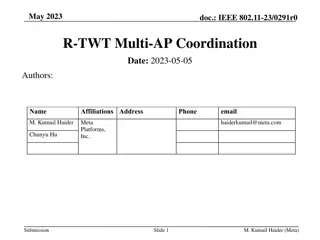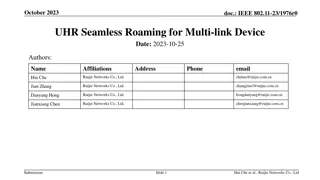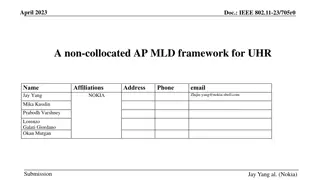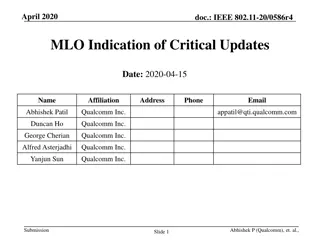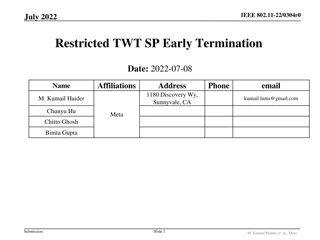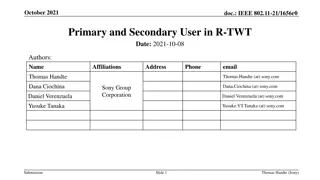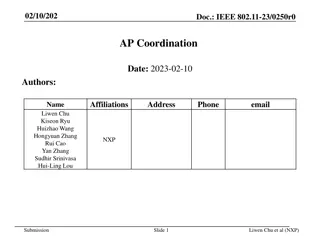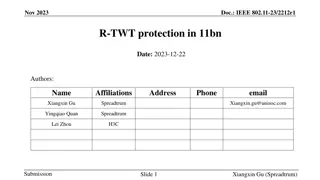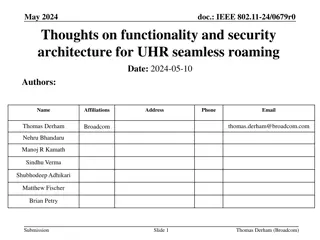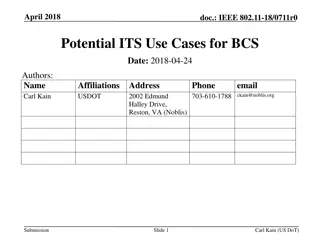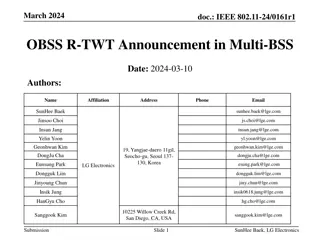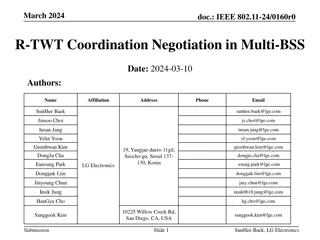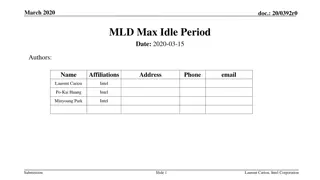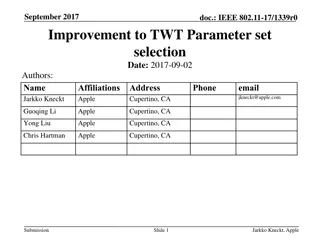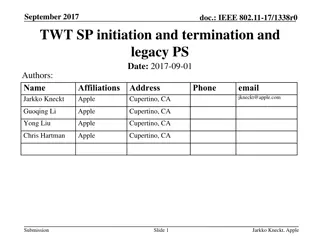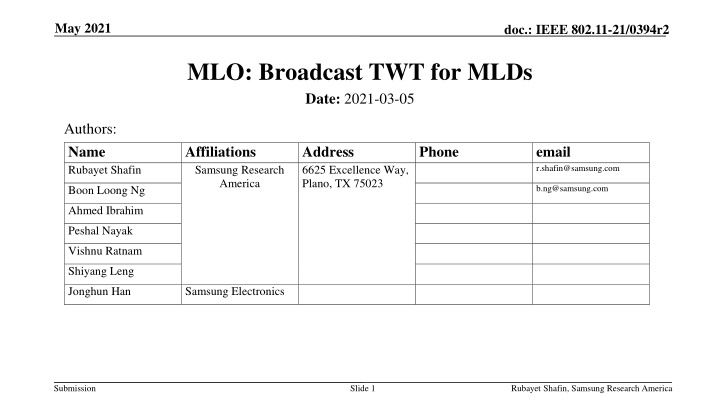
IEEE 802.11-21/0394r2 MLD Broadcast TWT Operation Details
Explore the broadcast TWT operation for Multi-Link Devices (MLDs) in IEEE 802.11-21/0394r2. Learn how MLDs can align TWT service periods across multiple links, benefit from latency-sensitive traffic management, and more. Discover the motivation behind using broadcast TWT for MLDs and its implications on network performance and traffic flow.
Download Presentation

Please find below an Image/Link to download the presentation.
The content on the website is provided AS IS for your information and personal use only. It may not be sold, licensed, or shared on other websites without obtaining consent from the author. If you encounter any issues during the download, it is possible that the publisher has removed the file from their server.
You are allowed to download the files provided on this website for personal or commercial use, subject to the condition that they are used lawfully. All files are the property of their respective owners.
The content on the website is provided AS IS for your information and personal use only. It may not be sold, licensed, or shared on other websites without obtaining consent from the author.
E N D
Presentation Transcript
May 2021 doc.: IEEE 802.11-21/0394r2 MLO: Broadcast TWT for MLDs Date: 2021-03-05 Authors: Name Rubayet Shafin Affiliations Samsung Research America Address 6625 Excellence Way, Plano, TX 75023 Phone email r.shafin@samsung.com b.ng@samsung.com Boon Loong Ng Ahmed Ibrahim Peshal Nayak Vishnu Ratnam Shiyang Leng Jonghun Han Samsung Electronics Submission Slide 1 Rubayet Shafin, Samsung Research America
May 2021 doc.: IEEE 802.11-21/0394r2 Background Broadcast TWT operation enables an AP to set up a shared TWT session for a group of STAs [1], [2] - Allows an AP to manage activity in the BSS - Minimize contention between STAs, minimize STAs awake time For MLDs, individual TWT operation could be set up on a setup link for more than one setup links [Motion 115, #SP60]. In this contribution, we address the broadcast TWT operation for multi- link devices (MLDs) Submission Slide 2 Rubayet Shafin, Samsung Research America
May 2021 doc.: IEEE 802.11-21/0394r2 Motivation With broadcast TWT for MLDs, STAs affiliated with non-AP MLD can become members of a particular TWT schedule where the TWT service period (SP) across multiple links corresponding to the STAs are aligned. In terms of traffic flow, the AP MLD/non-AP MLD can be benefitted from this SP alignment (more on this on the next slide) In addition, multiple MLDs can also become members of the same broadcast TWT schedule. Submission Slide 3 Rubayet Shafin, Samsung Research America
May 2021 doc.: IEEE 802.11-21/0394r2 Motivation (contd.) Latency-sensitive traffic can be bursty and periodic If there is a latency-sensitive TID, the non-AP MLD may want to map the TID to more than one (or all) setup links. For the latency-sensitive TID, STAs affiliated with the non-AP MLD may want to wake up at the same time so that the traffic corresponding to the latency- sensitive TID can flow over all the enabled links This will increase the channel access opportunity for latency-sensitive flow Reduced contention for latency-sensitive flow In such scenario, the non-AP MLD shall be benefitted if it becomes a member of a TWT schedule which can be aligned across multiple (or all) enabled links. Based on the TSF timer values for all links, AP MLD can align the wake time for that schedule across multiple links. In the Broadcast TWT announcement, AP MLD may indicate which schedule shall be aligned across multiple links The non-AP MLD can accordingly choose to become a member of that aligned schedule for frame exchange for latency-sensitive flow. Latency-sensitive Traffic Latency-tolerant Traffic MAC-SAP MAC-SAP STA3 STA1 STA2 STA3 STA1 STA2 bTWT Schedule A bTWT Schedule A bTWT Schedule A bTWT Schedule B Doze Doze Access Prob. = 1 1 ?3 ? Access Prob.= ? Submission Slide 4 Rubayet Shafin, Samsung Research America
May 2021 doc.: IEEE 802.11-21/0394r2 Broadcast TWT for MLDs (1/5) An MLD in a BSS may support broadcast TWT operation - TWT service period (SP) for any MLD supporting broadcast TWT operation can be either trigger-based or non-trigger based - A non-AP MLD may provide its broadcast TWT operation capabilities during ML setup When broadcast TWT is supported by both AP MLD and non-AP MLD, an STA affiliated with the non-AP MLD may receive the Beacon frame containing the broadcast TWT element from an AP affiliated with an AP MLD on any setup link. - The STA affiliated with the non-AP MLD on the link wakes up to receive the beacon frame and determines the starting time of the broadcast TWT SP. Submission Slide 5 Rubayet Shafin, Samsung Research America
May 2021 doc.: IEEE 802.11-21/0394r2 Broadcast TWT for MLDs (2/5) For Broadcast TWT operation for MLDs, there is a TWT schedule, namely Aligned Schedule. - Aligned Schedule: An Aligned schedule is defined as a Broadcast TWT schedule that shall be aligned across multiple links between the AP MLD and the non-AP MLD. When the AP MLD announces Broadcast TWT schedules, it shall indicate whether or not a particular Broadcast TWT schedule (corresponding to Broadcast TWT Parameter Set) is an Aligned schedule. Similarly, when non-AP MLD requests, suggests, or demands Broadcast TWT schedule for any link, it can also indicate whether or not it wants the requested, suggested, or demanded Broadcast TWT schedules to be aligned across multiple setup links. The Aligned Schedule can be applied to any subset of links between the AP MLD and non-AP MLD. Submission Slide 6 Rubayet Shafin, Samsung Research America
May 2021 doc.: IEEE 802.11-21/0394r2 Broadcast TWT for MLDs (3/5) AP MLD AP MLD AP1 AP2 AP3 AP1 AP2 AP3 Broadcast TWT agreement Broadcast TWT negotiation STA3 STA3 STA1 STA2 STA1 STA2 STA3 STA3 STA1 STA2 STA2 STA1 non-AP MLD-A non-AP MLD-B non-AP MLD-B non-AP MLD-A In this illustrative example, three links are set up between the AP MLD and non-AP MLD-A. Also, three links are set up between the AP MLD and non-AP MLD-B. Both AP MLD and non-AP MLDs support broadcast TWT operation. A broadcast TWT negotiation takes place between AP1 of AP MLD and STA1 of non-AP MLD-A. Similarly, another broadcast TWT negotiation takes place between AP1 of AP MLD and STA1 of non-AP MLD-B. After successful negotiation, same broadcast TWT agreement is established between AP1 of AP MLD and STA1 of non-AP MLD-A, AP1 of AP MLD and STA1 of non-AP MLD-B. Submission Slide 7 Rubayet Shafin, Samsung Research America
May 2021 doc.: IEEE 802.11-21/0394r2 Broadcast TWT for MLDs (4/5) Broadcast TWT Parameter Set In this illustrative example, three links are set up between the AP MLD and non-AP MLD. Both AP MLD and non-AP MLD supports Broadcast TWT. The scheduling AP MLD announces the existence of 2 Broadcast TWT Parameter Sets in the Broadcast TWT IE transmitted in the Beacon frame from the AP MLD to the non-AP MLD over Link 1. Moreover, the AP MLD also indicates that the TWT schedule corresponding to TWT Parameter Set A is an Aligned Schedule. A B The TWT scheduling AP MLD indicates Accept TWT in the TWT Setup Command field and sets up schedule corresponding to Broadcast TWT Parameter Set A across all three setup links between the AP MLD and non-AP MLD. Also three other Broadcast TWT schedules are set up on three different links. SPs can be aligned for MLO Non-AP MLD AP MLD Broadcast TWT IE A E Broadcast TWT SP A Broadcast TWT SP B STA1 AP1 Link 1 Beacon Doze Doze Broadcast TWT IE A F Broadcast TWT SP E Broadcast TWT SP A STA2 AP2 Link 2 Doze Beacon Doze Broadcast TWT IE Broadcast TWT SP A Broadcast TWT SP F STA3 AP3 Link 3 Doze Doze Submission Slide 8 Rubayet Shafin, Samsung Research America
May 2021 doc.: IEEE 802.11-21/0394r2 Broadcast TWT for MLDs (5/5) In this illustrative example, three links are set up between the AP MLD and non-AP MLD. Both AP MLD and non-AP MLD supports Broadcast TWT. The non-AP MLD transmits a frame on Link 1 containing a Broadcast TWT element to the AP MLD and suggests a particular Broadcast TWT schedule by setting the TWT Setup Command field to Suggest TWT. Moreover, the non-AP MLD indicates to the AP MLD that it wants the Broadcast TWT schedule to be aligned across setup links, Link 1 and Link 3. The AP MLD responds to non-AP MLD s suggestion with acceptance. The AP MLD creates a broadcast TWT schedule with the same Broadcast TWT Parameter Set contained in the Broadcast TWT IE in the TWT initiating frame transmitted by the non-AP MLD. The AP MLD then transmits a TWT IE to the non- AP MLD over Link 1 and Link 3 with that Broadcast TWT Parameter Set and indicates Accept TWT in the respective TWT Setup Command field. The AP MLD also indicates that the corresponding schedule across Link 1 and Link 3 are aligned. The Broadcast TWT Aligned Schedule is set up across Link 1 and Link 3. Broadcast TWT Parameter Set AP MLD Non-AP MLD Broadcast TWT IE Broadcast TWT SP AP1 STA1 AP1 STA1 Link 1 Beacon Broadcast TWT IE Frame containing Broadcast TWT IE AP2 STA2 Link 2 AP2 STA2 Beacon Broadcast TWT IE Broadcast TWT SP AP3 STA3 Link 3 AP3 STA3 Beacon Submission Slide 9 Rubayet Shafin, Samsung Research America
May 2021 doc.: IEEE 802.11-21/0394r2 Summary In this contribution, we propose the facilitation of broadcast TWT operation for MLDs - For any MLD, it is optional to support broadcast TWT operation - A non-AP MLD may provide its broadcast TWT operation capabilities during ML setup An Aligned Schedule is defined for Broadcast TWT operation for MLDs During Broadcast TWT announcement, an AP MLD may indicate whether or not a particular Broadcast TWT schedule is an Aligned Schedule. A non-AP MLD shall indicate whether or not it wants any particular Broadcast TWT schedule (Suggest TWT or Demand TWT) to be aligned across multiple links or whether it wants to join any existing Aligned Schedule. The Aligned Schedule can be established on any subset of links between the AP MLD and non-AP MLD. Submission Slide 10 Rubayet Shafin, Samsung Research America
May 2021 doc.: IEEE 802.11-21/0394r2 References [1] IEEE P802.11ax/D8.0 26.8.3 (Broadcast TWT operation) [2] IEEE P802.11ax/D8.0 10.47 (Target Wake Time) Submission Slide 11 Rubayet Shafin, Samsung Research America
May 2021 doc.: IEEE 802.11-21/0394r2 SP 1 Do you agree that in R1: - An MLD may support broadcast TWT operation Broadcast TWT negotiation can take place on any link between an STA affiliated with a non-AP MLD and an AP affiliated with an AP MLD that support broadcast TWT operation. Submission Slide 12 Rubayet Shafin, Samsung Research America
May 2021 doc.: IEEE 802.11-21/0394r2 SP 2 Do you agree that in R1: - For Broadcast TWT operation for MLDs, an Aligned Schedule is defined as a Broadcast TWT schedule that shall be aligned across multiple links between the AP MLD and non-AP MLD. During Broadcast TWT announcement, an AP MLD may indicate whether or not a particular Broadcast TWT schedule is an Aligned Schedule. A non-AP MLD shall indicate whether or not it wants any particular Broadcast TWT schedule to be aligned across multiple links or whether it wants to join any existing Aligned Schedule. The Aligned Schedule can be established on any subset of links between the AP MLD and non- AP MLD. Submission Slide 13 Rubayet Shafin, Samsung Research America


